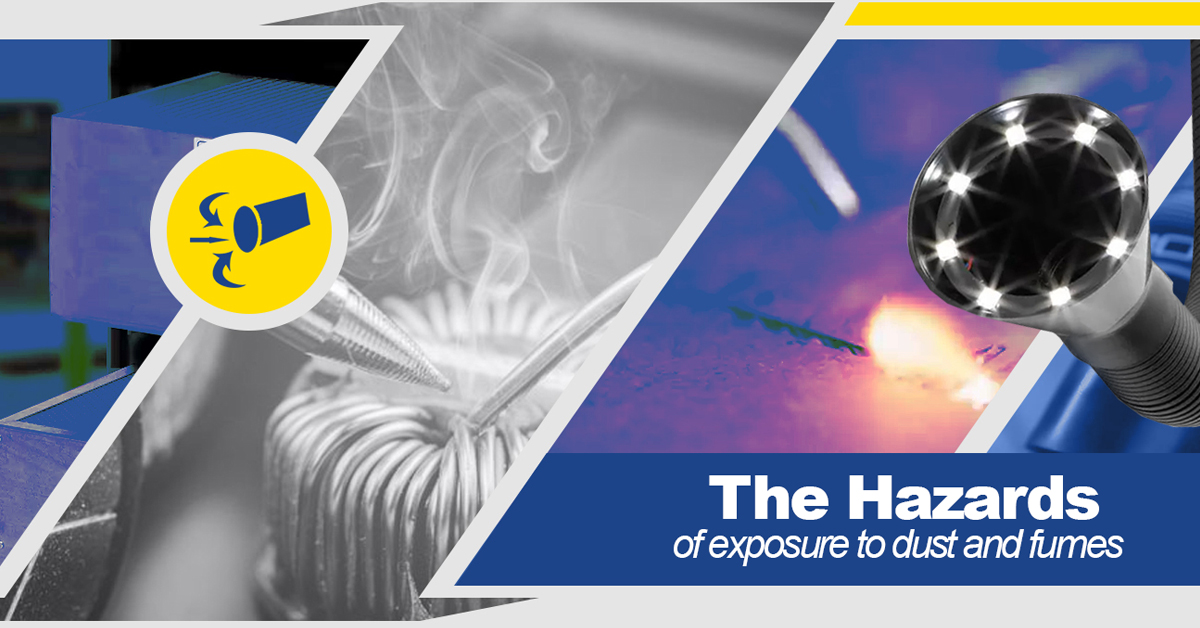
The hazards of exposure to dust and fumes.
Many industries have to deal with people being exposed to airborne dust and fumes, which poses a massive risk to human health. There is limited knowledge and awareness of this problem. Fortunately, the issue has gained more attention over the years, which has catapulted manufacturers into understanding what exposure can do and how to neutralise this.
Working conditions and the safety of people have improved drastically with the use of dust and fume extraction machinery and control procedures.
Where can exposure to hazardous dust and fumes occur?
You may not know it, but dust and fumes are generated in virtually any work environment, and consistent exposure does pose health risks.
Industries and workplaces where exposure can occur include but are not limited to:
- Vehicle manufacturing and repair shops (exhaust fumes and sanding & painting of cars)
- Manufacturing facilities such as the electronics industry (soldering, welding fumes, dust)
- Food processing and manufacturing (flour & other ingredients)
- School and college workshops (welding, woodworking, casting of metals)
- Beauty salons (solvents & dusted latex gloves)
What are the common health impacts of dust and fume exposure?
The effects of dust and fumes on a person’s health depend largely on the extent and type of exposure. An example of the effect of exposure is people who work in industrial bakeries, anyone working with paint sprayers, workers inhaling airborne metalworking fluids, and people inhaling solder fumes in the electronics industry are susceptible to Occupational Asthma.
Lung Cancer and Chronic Obstructive Pulmonary Disease are prevalent in welders as the welding fumes contain nickel and chromium. People who work with mineral dust risk developing various types of Pneumoconiosis, such as Asbestosis from asbestos and Silicosis from silica. Occupational Alveolitis is also a known risk for people who work in the food processing and manufacturing industry.
There are cases where substances and processes that were once thought to be non-carcinogenic have been reclassified as carcinogenic after more research. There has been a crucial re-evaluation of these substances and the danger they can inflict on people, even in small quantities.
What does the future look like with legislation and exposure to dust and fumes?
As knowledge and research increase on these harmful substances, exposure limits have gradually tightened for the safety of the work environment. An example includes when the European Union proposed to reduce the exposure limit of manganese (a substance found in welding fumes) from 0.5 milligrams per m3 to 0.2 milligrams per m3.
With stricter regulations and substance reclassification developing, the working environment where dust and fumes are a problem will continue to become a safer place.
Poor working practices and lack of knowledge surrounding dust and fumes resulted in many cases of Asbestosis, Silicosis and Lung Cancer. Fortunately, what was once considered acceptable is now prohibited. Regulations and restrictions will continue to increase for dust and fume exposure to safeguard workers and create a safe environment to work in.
Five ways to evaluate dust and fume exposure in the workplace.
Assessing and establishing how a company can work to lower dust and fume exposure is vital! The following factors should be considered:
- Elimination: Can the hazard be removed?
- Substitution: Can the harmful substances be exchanged for something less toxic?
- Engineering controls: Can the hazards be designed to come into less contact with the process operator?
- Administrative controls: Can new or different procedures lessen workers’ contact with unsafe substances?
- Personal Protective Equipment: Although not typically a highly effective measure, it should still be considered.
How can you negate the dangers of dust and fumes?
To limit workers’ exposure to damaging airborne dust and fumes, there are extraction solutions that are designed to capture as many contaminants in the air as possible.
Fume extractor systems remove hazardous particles from the air by using a fan with a negative draft to pull fumes and dust into a contained filtration system.
We know how harmful these dust and fumes can be and how much damage they can cause to a human. Using a fume extractor can prevent health risks from developing and keep the work environment safe.
J-Pak has a selection of fume extractors for the workplace, and our helpful reps would gladly assist with any questions and inquiries.
You can contact us at www.jpak.co.za/contact-us and have a look at our other blogs for more information on what we offer and how it can help you.
#JPak #Fumes #Dust #FumeExtraction #FumeExtractors #HazardousParticles #SafeWorkEnvironment #FumeSolutions #ManufacturingIndustry #FumeExtractionSystem #Filtration #FumeRemoval

